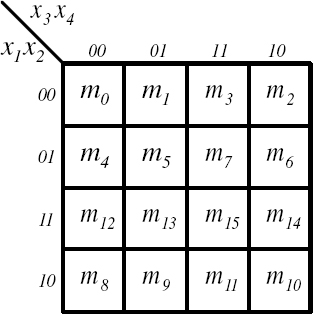6.6 FOUR-VARIABLE KARNAUGH MAP
A four-variable map is constructed similarly to the three-variable Karnaugh map, but now two three-variable maps are combined. Figure 6.6 shows the structure and minterm locations of a four-variable Karnaugh map. Notice that the values of x1 and x2 and of x3 and x4 count in the order 00, 01, 11, 10 rather than the usual 00, 01, 10, 11. This ensures that each cell varies by only one bit position from each adjacent cell. The map also wraps around itself, so the top and bottom cells are adjacent to each other. The cells of the rightmost column are adjacent to those in the leftmost column of the map. The four corner cells are also adjacent and form a group of four minterms.
Figure 6.7 shows an example of a four-variable function reduced in a four-variable Karnaugh map. Notice that just as the top and bottom edges of a map are adjacent, so are the right and left edges. This is shown by the 1's in the four corners of the map, which can be enclosed within one circle, forming a group of four 1's. The rest of the 1's are then enclosed within the other circles to complete the function as shown in Figure 6.7.

Figure 6.6 Four-Variable Karnaugh Map
In all previous examples, the Karnaugh maps had unique solutions for the function f. However, other choices are sometimes available to minimize the function. In this case the solution is not unique. Such an example is ...
Get Introduction to Digital Systems: Modeling, Synthesis, and Simulation Using VHDL now with the O’Reilly learning platform.
O’Reilly members experience books, live events, courses curated by job role, and more from O’Reilly and nearly 200 top publishers.

